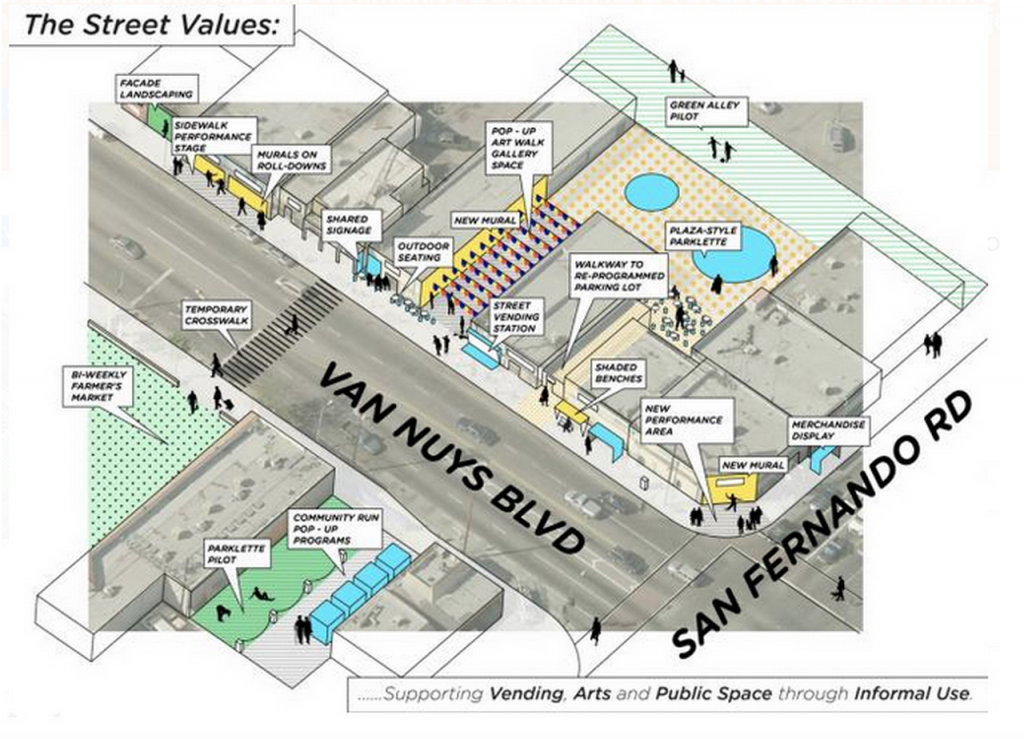“The informal placemaking that’s happened in this corridor has resulted in a rich sense of place and a real vibrancy,” says Max Podemski about Van Nuys Boulevard between Laurel Canyon and Bradley Avenue. “With our project—Pacoima Street Values: Supporting Vending, Arts and Public Space through Informal Use—we want to legitimize, formalize, and propagate it.”

According to Max, Planning Director at the local environmental justice organization Pacoima Beautiful, “existing businesses are already activating public space here. Owners have responded to our neighborhood’s increasing bicycle and pedestrian traffic: restaurateurs are knocking out walls to take their diners outside; neighbors are trying out different kinds of street furniture; vendors are selling their merch on sidewalks… We propose creating a ‘kit of parts’—essentially a list of useful tools and best practices—that pays homage to these DIY placemaking efforts while serving as a foundation for increased future enhancements.”
The corridor is slated for some major infrastructure changes. The Los Angeles Metro’s East San Fernando Valley Transit Corridor project, as well as initiatives brought by Councilmember Felipe Fuentes, are poised to dramatically restructure Van Nuys, a major thoroughfare that was originally designed primarily for car traffic.
“When you hear people talk about the neighborhood who have only driven through it, you would think it’s an underutilized place,” says Max. “But if you walk along it, you see all that’s really going on. When we drive—and people in L.A. drive fast!—we miss the richness along the street. All the little buildings have a store or restaurant in them; there are informal seating areas where people are hanging out. Our kit will formalize these local reinventions, and help to carry the neighborhood’s current vibe over when these big changes happen.”
“There will be two basic parts to it,” he explains. “One that will show tools and tactics for better pedestrian infrastructure: wider crosswalks, sidewalk extensions. The other will integrate the interventions businesses are already doing and formalize them into a unified design, and in some cases, actually help to make them legal! For example, a local restaurant could learn about more cost-effective urban furniture for their al fresco area, or about how far they can legally extend into the street.”
Pacoima Beautiful has been on Van Nuys since 1996. “We’ve always used a lot of community input,” says Max. “L.A., like a lot of places around the country, is struggling with issues of gentrification. Walkability and bikes have come to be known as instruments of gentrification, yet the vast majority of people in L.A. who use transit, bike, and walk are our low-income and immigrant populations. This project comes out of working with the existing community on these issues, instead of enacting a top-down plan where you’re dropping streetscape interventions from on high.
“We want to have this come up from what’s already on the street.”
“I love L.A.,” Max says. “It’s one of the most interesting and dynamic places in the country because we have this rich tapestry of cultures and people. As a planner, it’s also exciting to be here because it’s reinventing itself right now. We’re building five transit lines; reorienting the city around walking and revitalization. And a lot of this change is coming from the grassroots. We’ve seen change through the actions of elected officials who are really responding to our efforts.”
“It’s great to look at other cities and see what we can learn,” Max says, “but it’s also really satisfying to take what we’ve made as a community already and build it to the next level.”
“We want to do this in an L.A. way.”
***
Pacoima Beautiful would like to acknowledge the hard work and camaraderie of their partners at LA-Más.